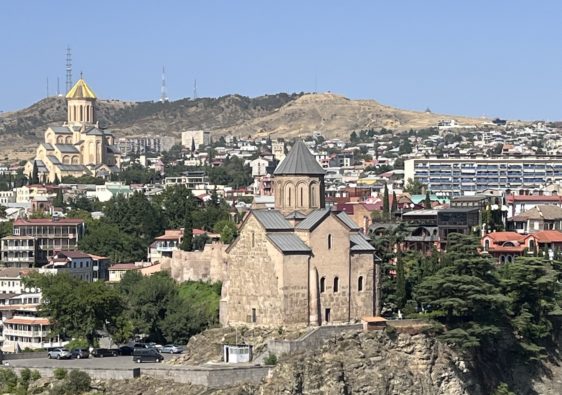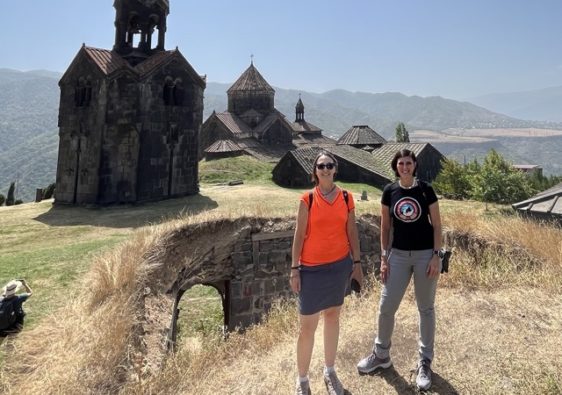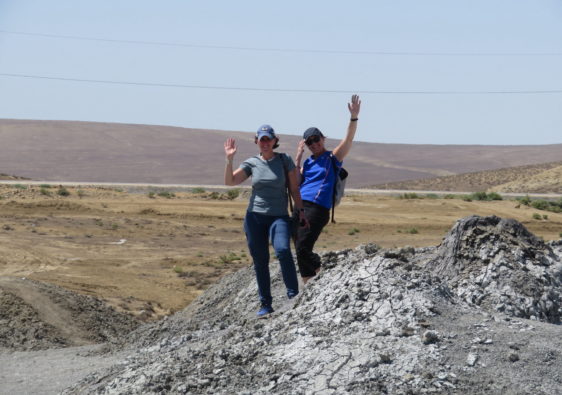If you’ve seen pictures of Georgia, you’ve probably seen pictures of Mt. Kazbegi, with the iconic church atop a hill in front of it. That is the image of Georgia we wanted to see, and that was the first tour we went on in Georgia.
We went with Select Georgia tours on a private tour. Our tour guide George spoke excellent English, was well versed in the history of the country and the individual sites. We highly recommend: https://www.tripadvisor.com/AttractionProductReview-g294195-d19914717-Kazbegi_Tour_with_Gergeti_Church_Waterfall_Hike_Hidden_Gems-Tbilisi.html
We drove up the Military Highway, which is the only road connecting Georgia to Russia, the route traveled throughout the ages, but hardened by the Russians in the late 1700’s as they were trying to subjugate Georgia and the region. I had read about the Military Highway, and pictured, well, a highway. It was a two-lane road, often hampered by construction blocking one lane, and often filled with cows. And of course, as the road is through the mountains, it is constantly winding and turning, and the cows or blockages can appear unexpectedly.
There seemed to be an unwritten law that any car that approached another car from the rear had to pass as quickly as possible – it was pass and be passed all of the time, and both lanes of traffic were constantly looking to pass each other, even as the roads turned, or were constricted by obstacles.
Driving is on the right side, but cars are allowed to have the driver on either the right side or the left side. Our driver’s seat was on the right, as his car was from Japan, which meant that he had to lean way to the left to see around the car in front before he could pass – which he always did as quickly as possible, because apparently that’s the thing to do. We had opted to take tours through the Caucasus versus getting a rental car and driving because we read the roads were dangerous – and this tour definitely made us feel we’d made the right choice.
Stop #1 – The Gergeti Trinity Church, which is the iconic church with the backdrop of the Kazbegi mountains. A few things about Georgian churches in general: 1st women must wear headscarves, but they’re usually provided in a box as you walk in, in case you didn’t bring one. 2nd There are no pews, as parishioners are expected to stand as they’re worshiping. 3rd a lot of the frescoes and other artwork was destroyed by the Russians when Georgia was part of the Soviet Union, in their effort to get rid of religion. [It didn’t work in Georgia!] 4th: some of the churches are incredibly old, as Georgia is one of the earliest Christian nations [they and Armenia both say they are 1st], and the guides we spoke to were incredibly proud of that.


Stop #2: A new church/monastery on a hill 1 km from the Russian border. We were able to see the trucks and cars lined up waiting to pass through the border, and could see the Georgian flag on the Georgian side of the border. [As the Russian war on Ukraine is in progress, some might question our wisdom in being that close to Russia. There was a lot of anti-Russian graffiti, but at the time Russian tourists were still able to come through, and the situation was safe there].


Stop #3: Hike to the Gveleti (small) waterfall. It wasn’t a long hike, fortunately, but it was hot, and we had elevation stealing the oxygen from our lungs, so we chose to go to the smaller of the waterfalls and didn’t make it to the large one. The “small” one was beautiful and well worth seeing.



Lunch: Rather than lunch at a restaurant, we ate at a home that had been turned into a B&B-style hostel. We had a family-style meal with the entire room to ourselves and an incredible view of the mountains in front of us. I’m a vegetarian and they had prepared numerous vegetable dishes so I had a variety of traditional foods to try – all of it was delicious.


Stop #4: one of the hidden gems. A stone carver had carved huge boulders the size of cars into faces. One was carved into Jesus and, there were other public figures that I didn’t know. He used a blowtorch to heat the carvings into the stone, not wanting to use chisels or anything unnatural. Fire is natural, sure, blowtorches not so much, but who am I to question his choices? It’s a kind of Georgian Mt. Rushmore, but still in the formative stages.
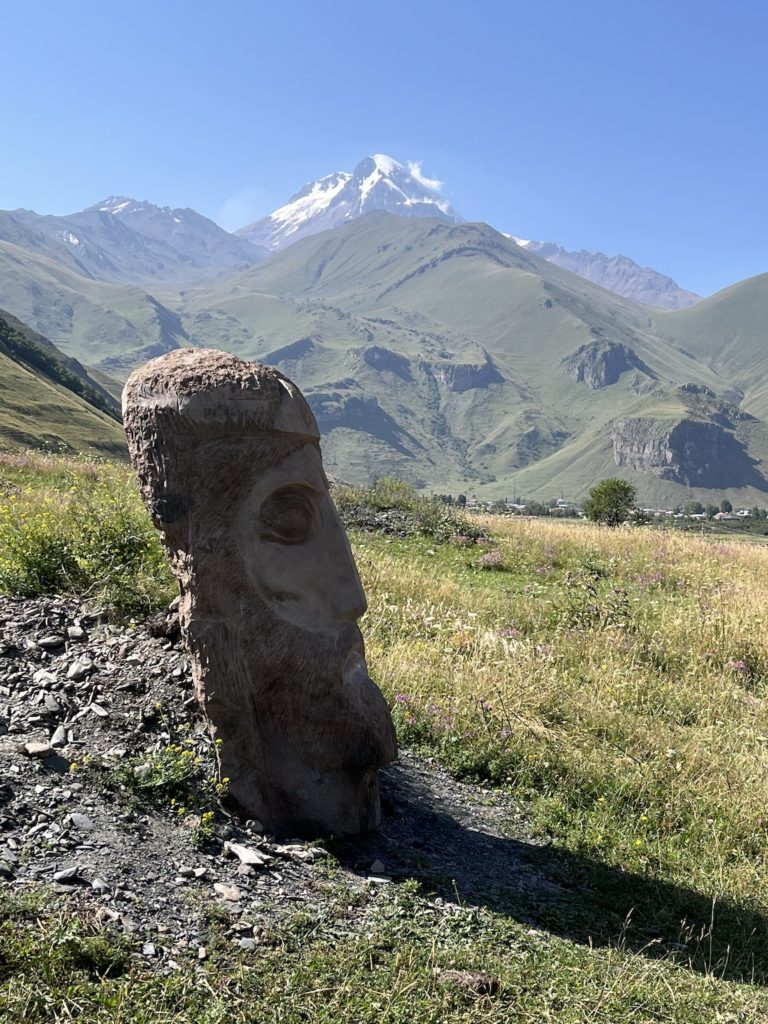
Stop #5 – Another old church on a hill, with a stone fire tower. The fire tower was one in a series of towers that were used to send alerts over long distances – they might be lit if the Russians were invading from the north, for example. They’re the kind of thing that you see in medieval or fantasy movies – but these were real life and still seemed to be in working condition [though not manned, of course]. We drove by another one in the line of towers and could see the network as we stood on top of the hill.
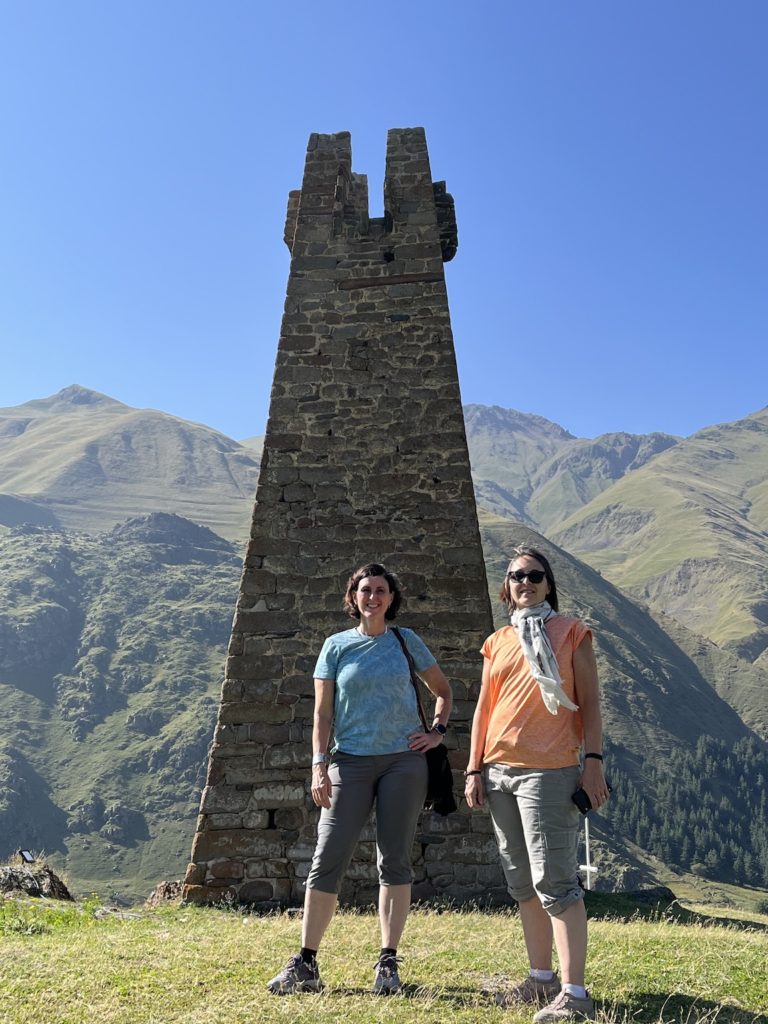
We were supposed to stop at a Panorama, a large mural with a view of the mountains. We had been seeing mountains all day so asked why this particular stop was any different than the other views of mountains. The guide said it had been built during Soviet times [1983] and was dedicated to Georgian – Russian friendship. The parking lot was overflowing, the day had been long, and we already knew about Russian “friendship” – so we skipped it. No regrets.
